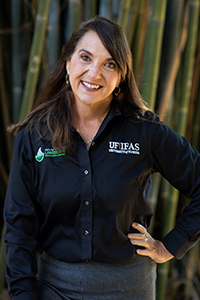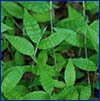Wendy's Wanderings
September 2, 2021
Weedin' Wendy
I don't know who needs to hear this, but you have some weeding to do. The hot summer temperatures and the abundant rainfall in the last few months have given a needed boost to landscape plants, but the weeds thought the encouragement was for them, too. In my properly mulched landscape beds—the ones that have at least 3 inches of a Florida-Friendly mulch—the weeds are suppressed. In the areas when the mulch is thin or washed away by the rains, the weeds are growing to beat the band. Some of my old rivals like chamberbitter and doveweed are making a strong showing this year.

Chamberbitter
Chamberbitter (Phyllanthus urinaria) is supposed to be a summer annual but in recent times it has chosen to be a year-long guest. The other name for this weed is gripe weed and I get it. It produces copious amounts of seeds, tolerates mowing, and can be a tough one to get rid of. Pulling chamberbitter will work early on but some gardeners resort to herbicides if the plants are tough and woody.

Doveweed
My other green enemy this summer has been doveweed (Murdannia nudiflora). It is such a sneaky bad actor. The leaves of this summer annual are just about the same length and width of St. Augustine grass and it grows only about 3 inches tall. So if you don't look carefully, it looks like you have a nice patch of St. Augustinegrass taking off. But I can assure you, my gardening friend, that this spiderwort relative is not a grass and it doesn't play well with others. Doveweed smothers out your desired grass and plants and then dies off with the first cold temperatures of the year, leaving a dead patch in the winter months. It has also been known to cause contact dermatitis in dogs. I use a hoe to remove the bigger patches, but most people prevent this weed with a pre-emergent herbicide in April. That means you have to prevent it before you see it, which is a good trick.

Basketgrass¹
Another weed that is showing up in some shady parts of the landscape is basketgrass (Oplismenus spp.). There are several species of basketgrass in Florida; one is native and two are introduced but they're all usually treated as weeds in the Florida home lawn. Basketgrass quickly takes over as a low-growing groundcover in shady landscapes. While it is green and fast-growing in the summer, it quickly dies in cooler temperatures, leaving bare patches where it took over from lawn grass. It seeds freely and spreads readily in bare spots. Hand pulling and hoeing work on this creeper. Follow that weed removal with a permeable weed cloth and 3 inches of mulch and you can keep basketgrass at bay."
Like many of you, I enjoy hand pulling weeds and have even been known to pull weeds on other people's property. You know it is me at your door because when I ring your doorbell and you don't see anyone through the peep hole it is because I am down pulling weeds on your front walk. This summer I met a woman at a botanical garden in Minnesota and she had a hand full of freshly pulled weeds. I said hello and then asked if she was a Master Gardener Volunteer, to which she replied, "How did you know?' The pulled weeds gave her away. If you want to learn more about weeds and their control visit UF/IFAS weed specialist Dr. Chris Marble's video collection; there you will find my green nemeses and many more.
-- Wendy Wilber
1. Basketgrass photo by Nancy Loewenstein, Auburn University, Bugwood.org

